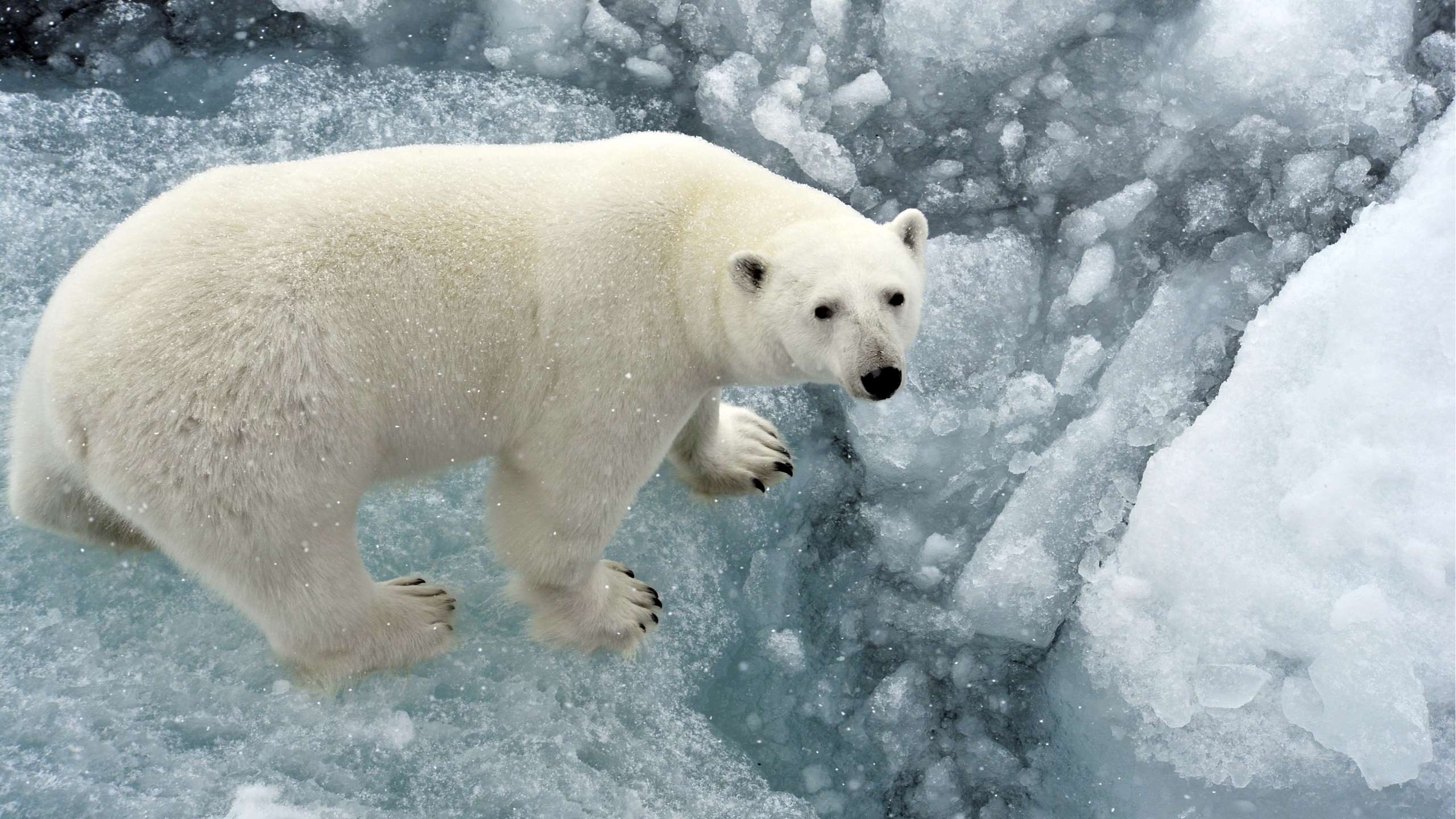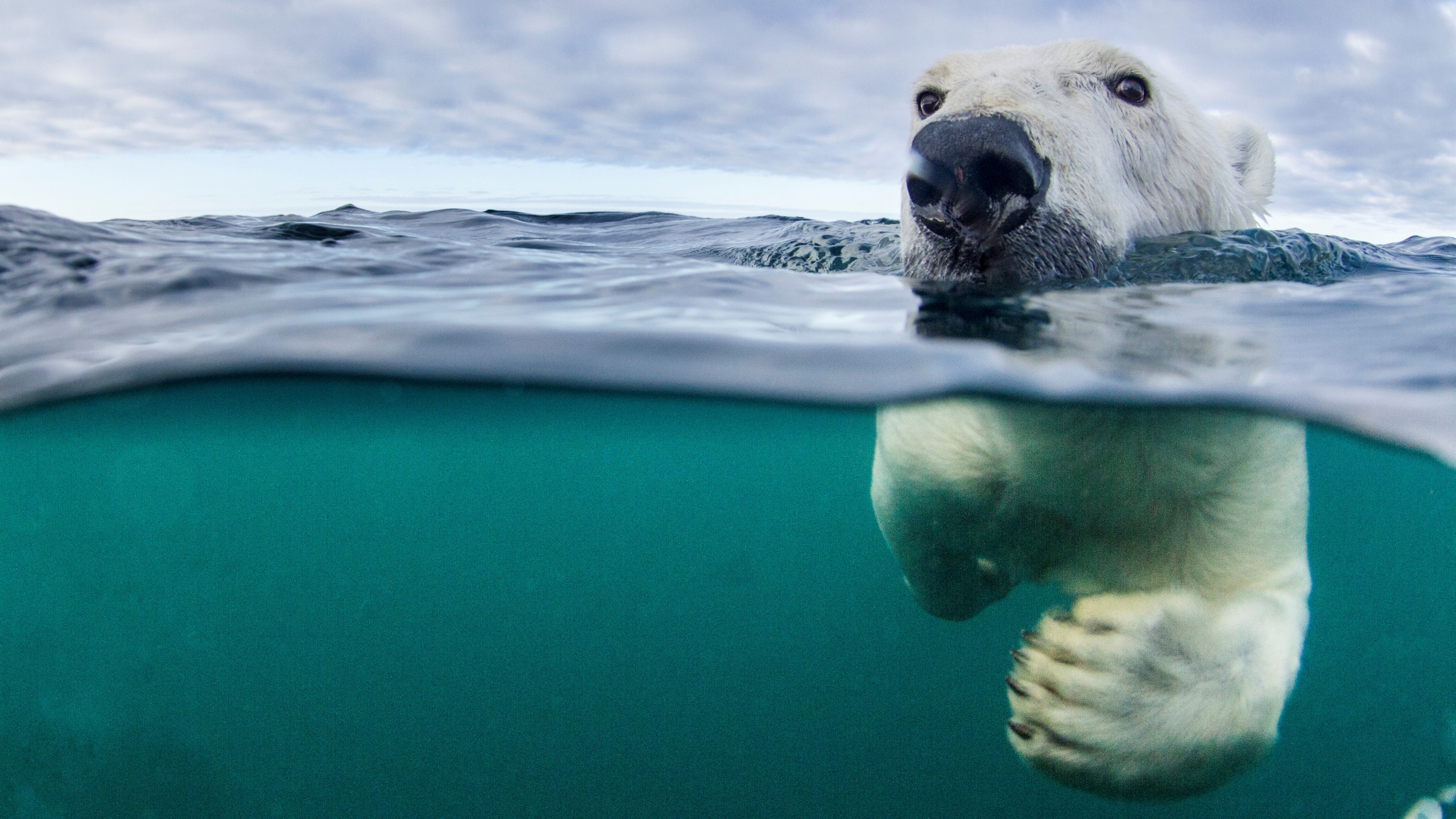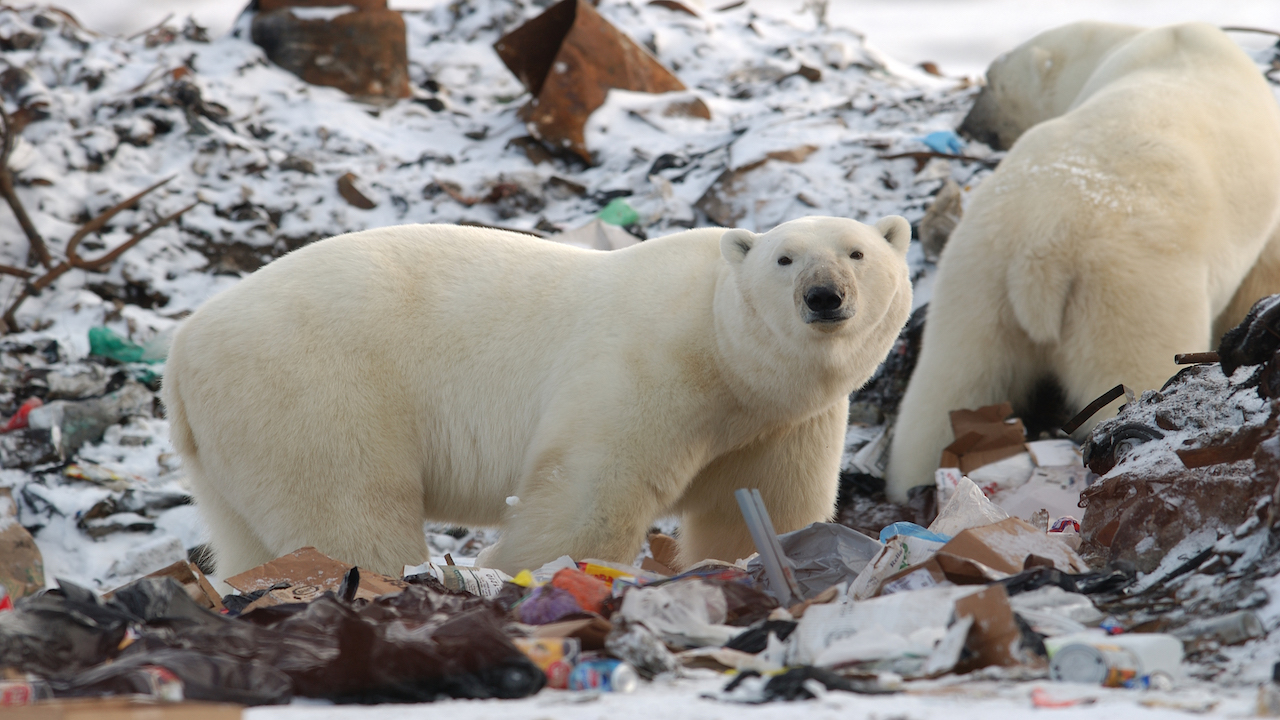Little Polar Bear Take Me Home Reading Level
Polar bears: The largest state carnivores

Polar bears (Ursus maritimus) are the largest carry species and the biggest land carnivores in the world. The enormous bears live in the Chill, where they prowl the icy expanse searching for seals, their preferred prey.
Polar bears likely evolved within the last 500,000 years when a population of brown bears traveled n into the Arctic during a warm period and became isolated. When temperatures dropped once more, the bears were forced to adjust to the colder environment, according to Aarhus University's Arctic Research Centre in Denmark.
Polar bears accept many adaptations for life in the frigid Chill, including dumbo fur and a thick layer of fat to keep them warm, also as modest bumps under their paws to stop them from slipping on the ice, co-ordinate to Polar Bears International. They are fantabulous swimmers, and their scientific name, Ursus maritimus, translates to "sea bear," according to the San Diego Zoo. Polar bears depend heavily on the body of water environment and are the only bears to be considered marine mammals.
Related: Polar comport photos: Stunning shots capture Earth's icons of climatic change
Size & appearance
Polar bears are usually 3.5 to 5 feet (1 to 1.five meters) tall at the shoulder on all fours, simply an adult male may achieve more than than 10 feet (3 k) when standing on its hind legs, co-ordinate to Polar Bears International. In 1960, a polar comport that was killed in Alaska stood 12 anxiety (3.seven m) alpine on its hind legs, according to the National Wildlife Federation.
Male person polar bears usually weigh between 770 pounds and more than one,300 pounds (350 to 600 kilograms). The 12-pes-tall Alaskan behave shot in 1960 is the heaviest recorded behave and weighed 2,210 pounds (1,000 kg). Females weigh one-half equally much as their male counterparts, at 330 to 650 pounds (150 to 295 kg), co-ordinate to Polar Bears International.
Fundamental FACTS
Size: 3.5 to 5 feet (ane.5 m) tall at the shoulder (all fours)
Life span: 15 to xviii years
Conservation condition: Vulnerable
Polar bear fur appears to be white but it's actually transparent; the white appearance is due to visible light scattering and reflecting back off clear, hollow strands of hair, according to Polar Bears International. Their white appearance enables the bears to alloy in with their snow-covered, icy environment. Polar bears can also appear xanthous or even brown and gray, depending on the flavour and light conditions. Polar bear peel is black and absorbs the heat of the sunday, which helps continue the bears warm.
Polar bears vs. Kodiak bears
Polar bears are the biggest bear species, simply Kodiak bears, a subspecies, or type of brownish acquit, can grow to about the same size every bit some polar bears. Kodiak bears alive on islands in the Kodiak Archipelago off southern Alaska, where they have been isolated from other brown bears for about 12,000 years, co-ordinate to the Alaska Section of Fish and Game. These brown bears can stand over 10 feet (3m) tall on their hind legs and weigh upwardly to 1,500 pounds (680 kg), according to the Alaska Section of Fish and Game.
Some sources, such as the Alaska Section of Fish and Game, claim that Kodiak bears are the largest bears on Earth. The defoliation is partly due to the fashion that "largest" is defined, because the answer varies depending on whether bears are measured past length, weight, or by the largest individual ever recorded, according to the Library of Congress in Washington, D.C. Polar bears are heavier and taller on average, but individual Kodiak bears may be larger than boilerplate-size polar bears.
Where practise polar bears alive?
Polar bears live on the ice-covered waters of the Arctic and countries around the Arctic Circle, including Canada, Alaska in the U.S., Greenland (office of Kingdom of denmark), Norway, Russian federation and occasionally Republic of iceland, according to the International Union for Conservation of Nature (IUCN). They are non found in Antarctica, where penguins live.
Some polar bears stay on permanently frozen sea ice in the Arctic Basin, but virtually live on the annual sea water ice that forms effectually the Chill Basin. This annual sea water ice melts in the summertime, and then polar bears are forced to spend several months on land while they look for it to freeze over again, according to the IUCN.

Polar bears swim between bounding main water ice and the shore, hunting downwardly prey, searching for mates, or just cooling off. They paddle through the water with their big front paws and use their back legs equally rudders, according to Sea Globe. They also have webbing between their toes, like to ducks' feet, which helps them swim.
Polar bears accept been recorded swimming for nearly ten days at a time and traveling up to 427 miles (687 kilometers) in a single swim without stopping to rest, Live Science previously reported. Long swims like this put polar bears at take a chance of drowning, but they may be forced to undertake such great journeys more often as warming temperatures associated with climatic change melt bounding main ice in the Arctic.
Related: Sweating the details: Polar acquit hits the treadmill for scientific discipline
What exercise polar bears swallow?
Polar bears are the most carnivorous bear species and almost exclusively eat meat. Their principal prey are ringed seals (Pusa hispida), according to the National Wildlife Federation. Polar bears will sit by a seal animate hole waiting for a seal to pop up and then they can take hold of information technology. The bears volition as well sniff out seal dens, then crash through the roof and impale the seals inside.
If polar bears have a plentiful supply of seals and are in adept health, they'll only eat the seal's blab, according to Polar Bears International. This is the highest calorie meal available to polar bears and helps them build up fatty reserves and stay healthy between feedings. Polar bears can consume 4.4 pounds (2 kg) of fatty each mean solar day, according to the Globe Wildlife Fund (WWF).
Polar bears will too hunt walruses, ocean birds, fish and modest mammals such as rodents; scavenge on whale carcasses and other dead animals; and eat small amounts of vegetation, according to the University of Michigan's Animal Diversity Web (ADW). However, these are culling food sources when seals aren't plentiful; seals are crucial to sustaining a polar acquit population. Polar bears are top of the food chain and have no natural predators other than humans.
Related: Polar bears now swallow dolphins, cheers to global warming
Life in the cold

Polar bears are lonely except for when a female parent is raising her cubs. However, unrelated bears will occasionally be seen together, such equally when they share a big whale carcass or garbage dump, or when they are waiting on land for bounding main ice to re-form, according to Bounding main World. They do not defend territories, but polar bears may occasionally fight over a carcass, and males may fight over a female during the breeding flavor, between March and June.
Male polar bears detect females by following their scent, and the pair may spend a week or more than with each other. After mating, fertilized eggs don't enter the female's uterus straight abroad, and this process is delayed until usually September or November, according to the San Diego Zoo. Polar bears accept a gestation catamenia of up to about seven months including this delayed implantation. Meaning females will dig a cavern in a snowbank to give birth in; chosen a maternity den. Polar bears do non hibernate in winter, dissimilar nearly brown bears and black bears, and will continue to hunt unless the conditions is extremely harsh.
POLAR Behave TAXONOMY
Kingdom: Animalia
Phylum: Chordata
Form: Mammalia
Order: Carnivora
Family unit: Ursidae
Genus & species: Ursus maritimus
Source: ITIS
A female polar bear gives birth in her den, typically to twins in December or Jan. Newborn polar comport cubs usually counterbalance merely 1.3 pounds (0.6 kg), co-ordinate to the San Diego Zoo. The cubs grow quickly on their mother's milk and will start exploring exterior their den by spring, although they don't travel far for the showtime 12 days or more than and still slumber inside the den at nighttime, according to Sea World. Polar carry cubs stay with their female parent for upwardly to three years learning how to survive. Wild polar bears ordinarily alive for 15 to 18 years just can survive into their 30s, according to Polar Bears International. A captive polar bear called Debby lived to exist 42 years sometime in Assiniboine Park Zoo in Canada. She was believed to be the earth's oldest polar comport when she died in 2008, according to Reuters.
Related: Polar bear torso cam shows predator's POV
Are polar bears unsafe to humans?
Polar bears rarely assault humans. A 2017 study published in the journal Wildlife Social club Bulletin cataloged 73 confirmed polar conduct attacks between 1870 and 2014, including 20 fatalities. The researchers found that nutritionally stressed male person bears were most likely to attack humans and that about attacks were predatory, meaning the bear was killing for nutrient. Polar bear attacks increased over the study menses, which is likely due to changes in their environment.
"The danger is the proximity to people, coupled with an increasing number of polar bears in poor body condition spending more time on shore. Both people and bears are trying to conform to rapid changes on the footing and at sea," Geoff York, study co-author and senior director of conservation at Polar Bears International, said in a statement at the fourth dimension. As sea ice declines and moves further from the shore, more polar bears spend longer periods on land, such as in Hudson Bay in northeastern Canada.
"Bears are at present having to make a choice as the water ice melts each year: Do they stay on the water ice and retreat with it into deep Arctic waters or do they bound, come to shore, and take their chances on state?" York said. "Those who come ashore may come into conflict with human communities or activities. And as they become more than desperate for food, they may well take higher risks."
Related: 52 polar bears 'invade' a Russian boondocks to eat garbage instead of starve to death

Are polar bears endangered?
Polar bears are vulnerable to extinction, according to the IUCN Blood-red List of Threatened Species. Climate change poses the biggest threat to their long-term survival equally increasing temperatures cause the Arctic body of water ice they depend on to compress. They are besides threatened by other human being-related activities, such equally oil and gas drilling in the Arctic, which increases the risk of negative human-behave interactions.
There are but about 26,000 polar bears living in the wild, according to the IUCN. However, estimating the number of polar bears is difficult because they live in such remote habitats at low densities, and data nearly their subpopulations is frequently poor or outdated. Polar bears are listed on the U.S. Endangered Species List as threatened and are protected under the Marine Mammal Protection Human action.
Inuit and Ethnic people still chase polar bears for food and clothing as role of long-held cultural traditions, but this hunting is carefully regulated. The Inuit people have long believed that polar bears, which they telephone call "Nanuq," are wise, powerful and near human being, co-ordinate to Polar Bears International.
Related: 'Pizzly' bear hybrids are spreading across the Chill cheers to climate change
Boosted resources
- The United States Geological Survey carries out long-term research on polar bears
- Polar Bears International has more than information about polar bears and conservation efforts to salve them.
- Children's Volume: "The Polar Comport" (Enchanted Panthera leo Books, 2016).
This article was originally written by Live Science contributor Alina Bradford and has since been updated.
Source: https://www.livescience.com/27436-polar-bear-facts.html

0 Response to "Little Polar Bear Take Me Home Reading Level"
Postar um comentário